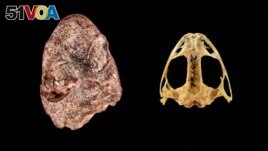25 March 2024
Scientists recently studied the fossil of a creature that lived in what is now the U.S. state of Texas about 270 million years ago. They named it Kermitops gratus in honor of Kermit the Frog from the children's television program The Muppets.
The fossil belongs to a group of animals that are thought to have given rise to modern-day frogs, salamanders, and limbless caecilians. Those animals, called amphibians, are creatures that can live both on land and in water.
And the study offers details into the history of how amphibians have evolved.

A composite image shows the fossil skull of the Permian Period proto-amphibian Kermitops (L) alongside a modern frog skull (Lithobates palustris), in this undated handout. (Brittany M. Hance, Smithsonian/Handout via REUTERS)
Only the head, or skull, was discovered. It measured around three centimeters long. Researchers think the amphibian-like creature had a wide body that was around 15-18 centimeters long.
Amphibians are one of the four groups of living vertebrates on land. The others are reptiles, birds, and mammals. Special details, or features, on the Kermitops skull are providing researchers with more information about the history of amphibians.
Calvin So is a George Washington University doctoral student. And he is the lead writer of the study recently released in the publication Zoological Journal of the Linnean Society.
So said Kermitops helps researchers understand the early history of amphibians by showing there is not a clear history "of step by step becoming more like the modern amphibian."
The fossil was collected in 1984 near Lake Kemp in Texas. It was kept in the large collection of the Smithsonian Institution's National Museum of Natural History in Washington, D.C. But it was not fully studied until recently.
Kermitops had facial features that were similar to frogs and salamanders. But it had palpebral bones or eyelid bones, that are not found in modern amphibians.
So said, "The length of the skull in front of the eyes is longer than the length of the skull behind the eyes, which differs from the other fossil amphibians living at the same time." He added that it might have enabled Kermitops to close its mouth faster than others to capture insects as food.
So added, "We really thought it looked like Kermit the Frog." That led researchers to name it Kermitops, meaning "Kermit face."
Kermitops lived about 20 million years before the worst mass die-off, or extinction, in Earth's history. And it appeared about 40 million years before the first dinosaurs. It lived alongside other members that formed the amphibian group.
The environment in which Kermitops lived appears to have changed back and forth between warm and wet seasons and hot and dry seasons.
So said, "This environment would be similar to modern-day monsoons that take place in the Southwest U.S. and Southeast Asia."
The fossil record of early amphibians and their ancestors is not complete. That makes it difficult to understand the beginnings of modern amphibians.
Arjan Mann of the National Museum of Natural History helped write the study. He said Kermitops shows the importance "of continuing to add new fossil data to understanding this evolutionary problem."
I'm Gena Bennett.
Will Dunham reported this story for Reuters. Gregory Stachel adapted it for VOA Learning English.
_________________________________________________
Words in This Story
fossil – n. something (such as a leaf, skeleton, or footprint) that is from a plant or animal which lived in ancient times and that you can see in some rocks
amphibian – n. an animal (such as a frog or toad) that can live both on land and in water
evolution – n. the process by which changes in plants and animals happen over time
vertebrate – n. an animal that has a backbone
monsoon – n. a wind in the Indian Ocean and southern Asia that brings heavy rains in the summer